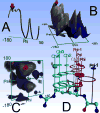Improving physical realism, stereochemistry, and side-chain accuracy in homology modeling: Four approaches that performed well in CASP8
- PMID: 19768677
- PMCID: PMC2922016
- DOI: 10.1002/prot.22570
Improving physical realism, stereochemistry, and side-chain accuracy in homology modeling: Four approaches that performed well in CASP8
Abstract
A correct alignment is an essential requirement in homology modeling. Yet in order to bridge the structural gap between template and target, which may not only involve loop rearrangements, but also shifts of secondary structure elements and repacking of core residues, high-resolution refinement methods with full atomic details are needed. Here, we describe four approaches that address this "last mile of the protein folding problem" and have performed well during CASP8, yielding physically realistic models: YASARA, which runs molecular dynamics simulations of models in explicit solvent, using a new partly knowledge-based all atom force field derived from Amber, whose parameters have been optimized to minimize the damage done to protein crystal structures. The LEE-SERVER, which makes extensive use of conformational space annealing to create alignments, to help Modeller build physically realistic models while satisfying input restraints from templates and CHARMM stereochemistry, and to remodel the side-chains. ROSETTA, whose high resolution refinement protocol combines a physically realistic all atom force field with Monte Carlo minimization to allow the large conformational space to be sampled quickly. And finally UNDERTAKER, which creates a pool of candidate models from various templates and then optimizes them with an adaptive genetic algorithm, using a primarily empirical cost function that does not include bond angle, bond length, or other physics-like terms.
Copyright 2009 Wiley-Liss, Inc.
Figures

References
-
- Krieger E, Darden T, Nabuurs SB, Finkelstein A, Vriend G. Making optimal use of empirical energy functions: force field parameterization in crystal space. Proteins. 2004;57:678–683. - PubMed
-
- Lee J, Scheraga HA, Rackovsky S. New Optimization Method for Conformational Energy Calculations on Polypeptides: Conformational Space Annealing. JComputChem. 1997;18:1222–1232.
-
- Sali A, Blundell TL. Comparative protein modelling by satisfaction of spatial restraints. JMolBiol. 1993;234:779–815. - PubMed
-
- MacKerell J, AD, Bashford D, Bellott M, Dunbrack RL, Evanseck JD, Field MJ, Fischer S, Gao J, Guo H, Ha S, Joseph-McCarthy D, Kuchnir L, Kuczera K, Lau FTK, Mattos C, Michnick S, Ngo T, Nguyen DT, Prodhom B, Reiher WE, Roux B, Schlenkrich M, Smith JC, Stote R, Straub J, Watanabe M, Wiorkiewicz-Kuczera J, Yin D, Karplus M. All-atom empirical potential for molecular modeling and dynamics studies of proteins. JPhysChemB. 1998;102:3586–3616. - PubMed
Publication types
MeSH terms
Substances
Grants and funding
LinkOut - more resources
Full Text Sources
Other Literature Sources
Miscellaneous

